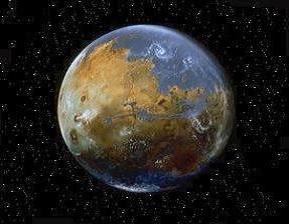

| Home | How to | Ethics | Greenhouse | Mission | Remembrance | Contributions | References | Authors |
RELATED SITES


|
The first and foremost action that needs to be done before actually attempting to terraform Mars is to create a fuel supply that will get us there and back. Once that has been developed, then we can start thinking of creating facilities and industries to support them. Since Mars is freezing cold and human beings are not able to breathe, increasing the atmospheric temperature, pressure and composition would be the first place to start the terraforming process. First we free up Mars permafrost layer and oxygen in the soil. Perhaps the fastest way of accomplishing this, is the use of nanotechnology. We would need to discover the technology to develop and construct 'nanites' to set free upon Mars; where they will free up the permafrost layer, release the oxygen molecules in the rocks and soil, prepare the soil composition for plant life, reproduce etc.. Nanites will have to be developed in isolation however, because of the possible dangers of the technology; humans on Mars will have to be protected or abandoned as others wait on moon stations for the duration of the nanites operation. The process would end when the atmosphere reaches a certain level and the nanites automatically shutdown, they would have to be shut down on command from orbit, or can be 'sterilized' from an orbiting platform. No matter what the case may be, the nanites should be biodegradable in the new martian atmosphere for safety. Discovering how much CO2 Mars actually has, is the next step so that we can create a global warming effect. We will also need to discover how to release it into a form that plant life can use. Once the needed CO2 is released into the planet's atmosphere, in a suitable form for plants, this transition will warm the planet enough to start melting ice into water. When water appears, plants will be introduced to help create oxygen. After a period of time, shallow seas and lakes will begin to form. Large bodies of water would also help in the conservation of solar energy. These bodies of water would also provide shelves as a medium in which biological organisms could start their life process. Prokaryotes and eukaryotes will adapt genetically to Mars and may be first to help in the formation of an atmosphere. The goal will be to create an atmosphere that is possibly thicker than Earth's atmosphere with high ozone contents to try and prevent harmful UV radiation from reaching the surface. High levels of CO2, water vapor, methane, and such that cause 'greenhouse effects' to help raise the overall temperature of the planet. The oxygen content should be such to prevent human colonist from evolving smaller lung capacity if possible in the thicker atmosphere. There are many ways to terraform a planet; this is simply one possibility: Other options include recreating volcanic activity and plate tectonic activity. Most ideas in reviving Mars are purely hypothetical; however, the possibility of terraforming cannot exist without the knowledge of how the red planet died. |